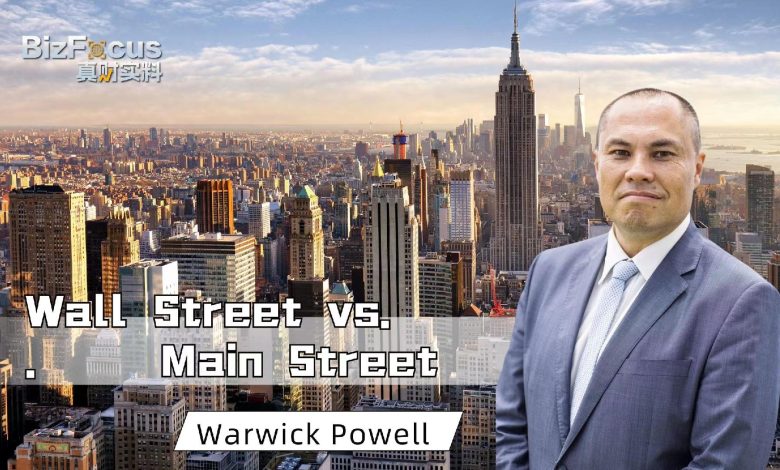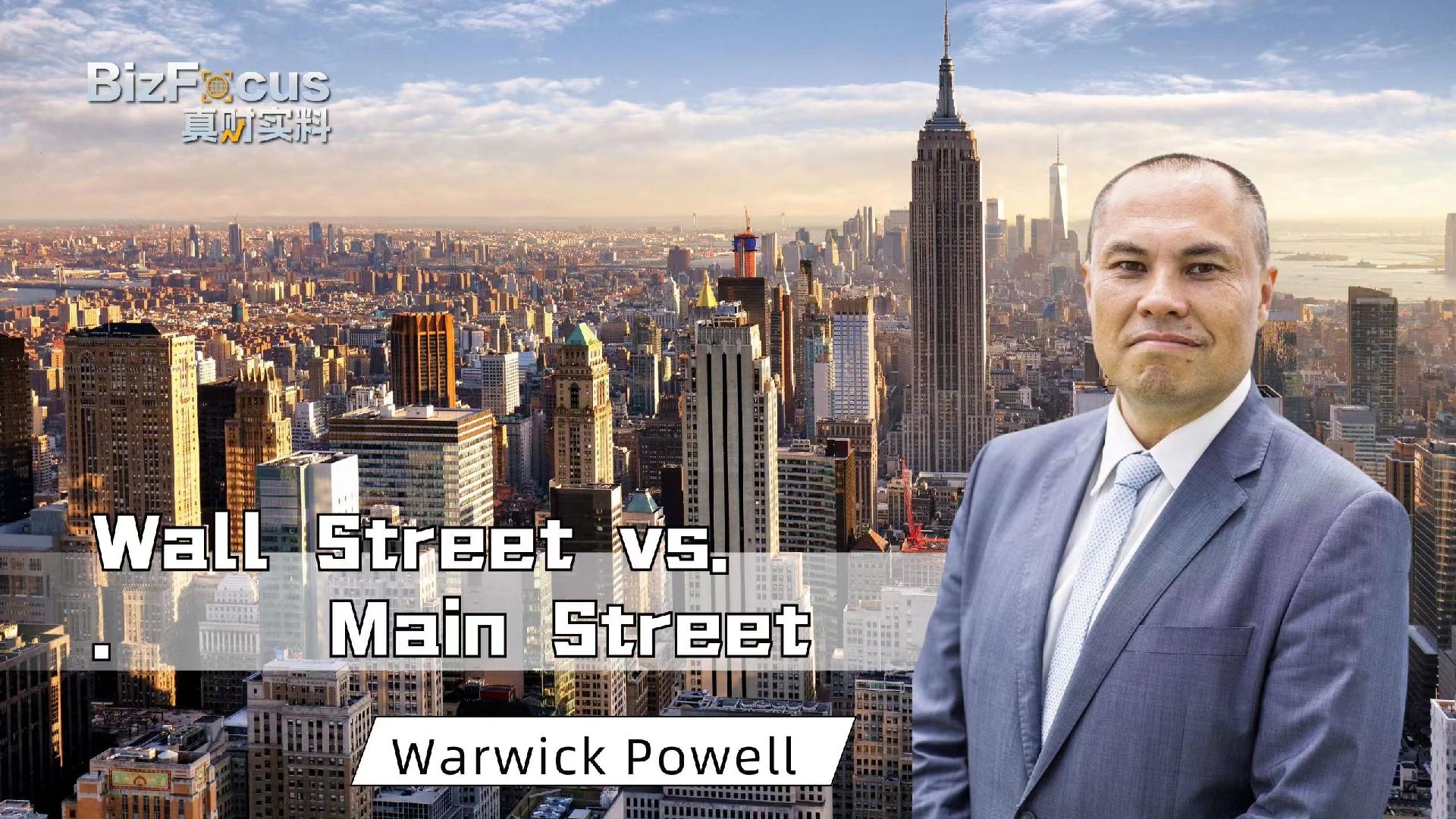Wall Street vs. Main Street: Imbalances in America's Political Economy


<img src='https://news.cgtn.com/news/2024-07-31/Wall-Street-vs-Main-Street-Imbalances-in-America-s-Political-Economy-1vGppaU6kZq/img/c9777836283c4ef199122360c535f2ad/c9777836283c4ef199122360c535f2ad.jpeg' alt=''
Editor’s note: Warwick Powell is an adjunct professor at Queensland University of Technology and senior fellow at Taihe Institute. The article reflects the author’s opinions and not necessarily the views of CGTN.
America’s gross federal debt surpassed 35 trillion U.S. dollars at the end of July 2024, to the gasp and outcry of many. Much hand-wringing has ensued in the face of this apparent eye-watering level. Some warn of a ticking fiscal time-bomb, oblivious to the fact that the U.S. treasury is actually able to print as many dollars as it needs.
The consternation isn’t debt per se, which in any case is probably the wrong way to describe and understand the mechanics and accounting of government appropriations. Put plainly, the U.S. government itself cannot ever default on so-called debts denominated in the currency that it issues. That said, this doesn’t mean there aren’t implications and constraints on the unfettered issuance of dollars. A rising “federal debt” rings warning bells not about an impending government or national default event but about just how out of balance the American political economy has become.
Aside from the expansion of the fiat currency money supply (government appropriations), money supply in the U.S. also expands due to the growth in bank credit. This money supply expansion has effects by virtue of where this money flows, and what resources are mobilized as a result.
<img src='https://news.cgtn.com/news/2024-07-31/Wall-Street-vs-Main-Street-Imbalances-in-America-s-Political-Economy-1vGppaU6kZq/img/82c35c32a4b44a4eb260b82b6d581e6a/82c35c32a4b44a4eb260b82b6d581e6a.jpeg' alt='A sign for Wall Street hangs in front of the New York Stock Exchange on July 8, 2021. /CFP'
Over the past few decades, the American political economy has increasingly financialized, meaning that the role of financial products, such as insurance, and associated markets for financial instruments (such as stocks, bonds, fx trading, futures and other derivatives) and a limited range of fixed assets – principally in commercial real estate – has expanded rapidly. Financialization has underpinned a growing imbalance in the productive capacity of the economy, with demographic distributional implications.
Using the IMF’s index of “financial development,” economist Imad Moosa, for example, showed that as financialization expanded, manufacturing employment in the U.S. contracted. Financialization is a structural feature of contemporary American capitalism as money supply growth expanded at a rate faster than could be absorbed by the real economy at acceptable rates of profitability. Finance capital privileges rapid monetized profit-taking, and the expanding markets of financial products and fictitious capital satisfy those requirements far better than the much slower dynamics of fixed capital formation and the production of things. Speculative trading of securities and legal rights to future value was more profitable than just about anything else.
The extra system liquidity simply has to go somewhere.
Expanded volumes of new money in the U.S. economic system (public fiat/debt and private credit growth) as tracked by the rate of M2 money supply growth, unsurprisingly correlates with the rate of growth of the S&P 500. Similarly, growth in the M2 money stock positively correlates with the rise in the U.S.-dollar price of gold. The explosion of trading volumes in financial products underpinned the concentration of financial wealth and economic power that has become a feature of contemporary American capitalism. According to Fed data, the wealthiest 10 percent of Americans now own 93 percent of stock value. A recent Oxfam report shows that the top one percent of American corporations own 97 percent of U.S. corporate assets. Economists Spencer Kwon, Yueran Ma and Kaspar Zimmerman have shown the long-run tendency for the concentration of American capital across all industries, with manufacturing concentration dynamics taking place most obviously in the 1970s.
<img src='https://news.cgtn.com/news/2024-07-31/Wall-Street-vs-Main-Street-Imbalances-in-America-s-Political-Economy-1vGppaU6kZq/img/0121c31051ec45798130b1aca5d8ddc6/0121c31051ec45798130b1aca5d8ddc6.jpeg' alt='A pedestrian walks along Wall Street in front of the New York Stock Exchange on Dec 9, 2020. /CFP'
Expanding bank credit in the U.S. in the past few years saw rapid growth in the asset values of commercial real estate (CRE). This dynamic acted as a honey pot for private equity and private credit, which injected additional capital into the CRE sector. High vacancy rates in CRE (18.1 percent as at June 2024) and rising lease payments delinquencies are now creating significant risks of loan defaults as over 260 billion U.S. dollars of loans mature by 2026.
The rapid expansion of the private credit market in the U.S., to over two trillion U.S. dollars, is symptomatic of unbalanced financialization. Private credit has offered and delivered higher returns, compared to the S&P for example, providing finance to higher risk projects and asset classes. However, one is left to wonder the extent to which the explosion in private credit is symptomatic of what Hyman Minsky called the Ponzi phase of credit in the leadup to systemic credit contraction. In this case, the recent concerns about the private credit market expressed by the IMF bear noting.
The latest symbolic threshold of federal government debt points to structural imbalances in the American political economy. While the federal government by definition cannot “go broke,” the ongoing expansion of money supply is conditioned by the limitations of the real economy. Due to the explosion of fictitious capital markets over the past four decades, rising public and private credit (new money) has contributed to the hollowing out of American industry and the concentration of wealth and power in an increasingly smaller proportion of people.
Wall Street has expanded at the expense of Main Street.





